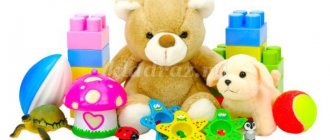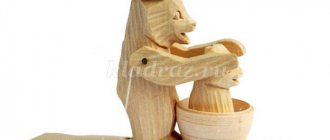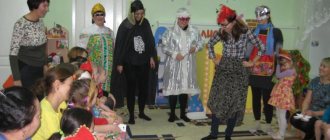Progress of the lesson
Creating a favorable emotional background, conditions for positive motivation for classes . Educator: Let's start our lesson by smiling at each other . Hold hands, turn your head to your friend on the left, then on the right and smile.
Educator: Guys, guests have come to us, let's smile at them and say hello! Main part
-We turned around, spun around and we found ourselves at the exhibition! 1. Didactic game “Wild and Domestic Animals”
Educator. Take the picture and look at it carefully . Whoever has a domestic animal is depicted, go to the house, and whoever has a wild animal, go to the tree. Children independently choose a picture , determine which animal is drawn and where it lives.
- Well done, now let's check: name domestic animals, and now wild animals.
- Now we have completed the task, let's return the paintings to the exhibition .
Educator. Name what animals you see at the exhibition? Who was attentive and noticed which animal was missing? And for those who haven’t guessed yet, this riddle will help: He is friends with the owner, he guards the house. Lives under the porch. Tail in a ring. ( Dog )
2. Looking at the painting “ Dog with Puppies ”
Now from the exhibition of
paintings we will move to another hall of paintings .
Display of the painting ( the painting is covered with a blanket )
.
- Guys, look at the picture (take off the cover, I’ll ask questions, and you answer, just don’t repeat your friend’s answer.
We walk like dogs (children walk, raising their knees high)
And we carry out the commands:
(stop)
Sit down - stand up!
Sit down - stand up! (sit down and stand up)
And run in a circle!
(run in a circle)
.
The teacher invites 2-3 children to tell about the picture .
«The picture is called «…»
.
It depicts (
a dog with puppies ) .
The dog is big... (shaggy, red, kind)
.
Next to her... (two puppies)
.
They... (small, fluffy, clumsy)
.
One sits... Another (stands and looks at the sparrows)
.
The owner... (brought
food for the dogs ) .
To the bowl... (sparrows flew in)
.
Sparrows do not fly away (because they are not afraid)
.
I liked the picture because the dogs... (kind)
.”
The teacher listens to the children's stories , encouraging their attempts to tell stories .
-Well done children, what beautiful and meaningful stories you have created . Now it's time to return back to the group .
-They turned around, turned around and came back!
— What did you like most?
- What picture were we looking at ?
- Let's say goodbye to our guests - goodbye.
Summary of a speech therapy lesson on the development of coherent speech. Compiling a descriptive story based on the painting “We are not afraid of frost” Municipal preschool educational institution “Kindergarten “Beryozka” Summary of a speech therapy lesson on the development of coherent speech.
Summary of GCD in the middle group “Storytelling based on the painting “Dog with Puppies” Synopsis of GCD in the middle group “Storytelling based on the painting “Dog with Puppies”. Topic: “Storytelling based on the painting “Dog with Puppies.” Target:.
Summary of a lesson on speech development in the middle group “Composing a story based on the painting “Dog with Puppies” Summary of a lesson on speech development in the middle group “Composing a story based on the painting “Dog with Puppies” Goal: Development of speech activity.
Summary of a lesson on speech development in the second junior group “Composing a story based on the painting “Spring” MUNICIPAL BUDGET PRESCHOOL EDUCATIONAL INSTITUTION KINDERGARTEN No. 15 Summary of a lesson on speech development in the 2nd junior group.
Open lesson on speech development in the middle group. Compiling a story based on the painting “Hedgehogs” Program content: learn to compose a story based on the painting; teach children to answer questions about the content of the picture, grammatically correct.
Summary of a lesson on speech development “Composing a story based on the painting “Fox with Cubs” Topic: “Composing a story based on the painting “Fox with Cubs”” Purpose: to develop the ability to come up with a plot story, observing consistency.
Summary of a lesson on speech development “Storytelling based on the picture “Dog with puppies” in the middle group Goal: teach children to describe the picture in a certain sequence. Name the picture. Introduce children to poetry. Tasks: “Speech development”:.
GCD summary for speech development in the middle group in the form of storytelling based on the painting “Dog with Puppies” GCD summary for speech development in the middle group Topic: “Storytelling based on the painting “Dog with Puppies” Purpose: to teach children to describe the picture.
Source
GCD for speech development Storytelling based on the painting “Dog with puppies”
.
Educator: Well done! Let's take a closer look at the picture that Dunno brought us. Educator: Children, first we must come up with a name for this picture. (Individual answers.) The teacher listens to the children, corrects their answers, and explains that the title of the picture should not be very long.
The teacher approves of the following titles: “A Dog and Its Puppies”, “Dog Yard”, “About Dogs”, etc.
Educator: I like the name “Dog with Puppies.”
Dunno: Let's go into the picture, guys, and imagine that we are nearby. What do you hear?
Children: Sniffle, yelp, growl, bang on the plate.
Dunno: Pet the dog and puppies , how do you feel?
Children: They are soft, shaggy, warm.
Educator: In order for the story based on the picture to be interesting, without repetition, you must first tell everything about the dog, then everything about the puppies and, finally, describe the yard itself. So, focus on the dog.
-Mom-dog, which one? (Individual answers: big, shaggy, spotted);
- What is she doing? (Choral answers: lying, resting, looking after puppies, etc.)
After listening to the children, the teacher summarizes what was said and gives a sample story:
“This painting shows a dog with two puppies.
The dog is large, shaggy, spotted. She lies and watches her puppies.” Then he offers to talk about the puppies, asks clarifying questions, corrects the children’s answers, etc.:
- Who is standing next to the dog? (Choral responses.)
— Mom is a big dog, what about the puppies? (Choral responses.)
- What puppies? (individual answers: small, cheerful, funny, spotted)
- What are the puppies doing? (Individual answers.)
—Which puppy, (child’s name), do you like best? Tell me about him. (With the help of leading questions, the child tells what kind of puppy it is, where it is relative to the mother dog and what it is doing.)
- Who will tell about the other puppy? (The wishing child also describes the other puppy)
The teacher invites the children to make several sentences. The teacher gives a short assessment of the story .
Educator: Dunno, listen to my story . This painting is called " Dog with puppies "
.
(descriptive story by the teacher based on the picture )
.
After listening to the children, the teacher summarizes what has been said and gives a sample story: “There is a small, fluffy puppy standing next to the dog. He stuck out his tongue and looked at the sparrows that had arrived. A little further away there is another puppy. He is small, fluffy with his tail raised up. He also looks at the sparrows that have arrived.”
Educator: Now we need to describe the yard in which the dog and puppies live. The teacher ensures that children correctly designate spatial landmarks and specify where it is - there, here (near, nearby, in, at, etc.):
—Where do dogs live? (choral answers.)
-Who built the kennel for them? (individual answers.)
— Who brought the dogs food? (choral answers.)
-Who flew to them? (choral answers.)
-What do sparrows do? (individual answers.)
Educator: Well done, guys. Now listen to me talk about this picture.
Sample teacher
: This painting shows a dog with two puppies. The dog is large, shaggy, spotted. She lies and watches her puppies. Next to the dog is a small, fluffy puppy. He stuck out his tongue and looked at the sparrows that had arrived. A little further away there is another puppy. He is small, fluffy with his tail raised up. Caring people built a kennel for them and brought food for them. Two sparrows flew to them. One sparrow pecks at their food, and the other looks at it.
Dunno: Very good stories. Thank you, you helped me a lot.
Educator: Guys, Pinocchio says thank you very much for your help. Now he knows how to tell his friends what is shown in this picture. I suggest our guest show one more game. Do you agree? Offer the children a game.
Didactic game: “Assemble a picture” Educator: You need to lay out the whole from the parts and then tell who you get.
(The teacher gives the children cut-out pictures of pets. The children come to the tables and complete the task; while the task is completed, calm music sounds.
Warden: Who did you get? What animal is this? What is her cub's name? That’s great, everyone coped with the task and helped Dunno. Summary of the lesson.
Dunno: You made up some interesting stories based on my picture and helped collect the animals. I will still come to your group .
Educator: What new have we learned? What were we doing? Who came to visit?



